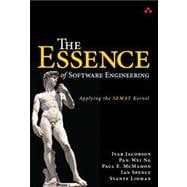
What is included with this book?
Dr. Ivar Jacobson, one of the prime movers behind SEMAT, is the principal author of six books, including, with Pan-Wei Ng, Aspect-Oriented Software Development with Use Cases (Addison-Wesley, 2005). Dr. Pan-Wei Ng has multiple roles within Ivar Jacobson International, including the definition of best practices in architecture, use cases, and iterative development. Paul E. McMahon, principal of PEM Systems, is the author of Integrating CMMI and Agile Development (Addison-Wesley, 2011). Ian Spence, CTO and Chief Scientist at Ivar Jacobson International, is the coauthor of Managing Iterative Software Development Projects (Addison-Wesley, 2007). Svante Lidman has more than twenty years of experience in software development, primarily working with software development processes and related tooling.
Foreword by Robert Martin
Foreword by Bertrand Meyer
Foreword by Richard Soley
Preface
Part I: The Kernel Idea Explained
Chapter 1: A Glimpse of How the Kernel Can Be Used
Chapter 2: A Little More Detail about the Kernel
Chapter 3: A 10,000-Foot View of the Full Kernel
Chapter 4: The Kernel Alphas Made Tangible with Cards
Chapter 5: Providing More Details to the Kernel through Practices
Chapter 6: What the Kernel Can Do for You
Part II: Using the Kernel to Run an Iteration
Chapter 7: Running Iterations with the Kernel: Plan-Do-Check-Adapt
Chapter 8: Planning an Iteration
Chapter 9: Doing and Checking the Iteration
Chapter 10: Adapting the Way of Working
Chapter 11: Running an Iteration with Explicit Requirement Item States
Part III: Using the Kernel to Run a Software Endeavor
Chapter 12: Running a Software Endeavor: From Idea to Production
Chapter 13: Building the Business Case
Chapter 14: Developing the System
Chapter 15: Operating the Software
Part IV: Scaling Development with the Kernel
Chapter 16: What Does It Mean to Scale?
Chapter 17: Zooming In to Provide Details
Chapter 18: Reaching Out to Different Kinds of Development
Chapter 19: Scaling Up to Large and Complex Development
Part V: How the Kernel Changes the Way You Work with Methods
Chapter 20: Thinking about Methods without Thinking about Methods
Chapter 21: Agile Working with Methods
Part VI: What’s Really New Here?
Chapter 22: Refounding Methods
Chapter 23: Separation of Concerns Applied to Methods
Chapter 24: The Key Differentiators
Part VII: Epilogue
Chapter 25: This Is Not the End
Chapter 26: … But Perhaps It Is the End of the Beginning
Chapter 27: When the Vision Comes True
Appendix A: Concepts and Notation
Appendix B: What Does This Book Cover with Respect to the Kernel?
Appendix C: Bibliography
What People Are Saying about This Book
The New copy of this book will include any supplemental materials advertised. Please check the title of the book to determine if it should include any access cards, study guides, lab manuals, CDs, etc.
The Used, Rental and eBook copies of this book are not guaranteed to include any supplemental materials. Typically, only the book itself is included. This is true even if the title states it includes any access cards, study guides, lab manuals, CDs, etc.